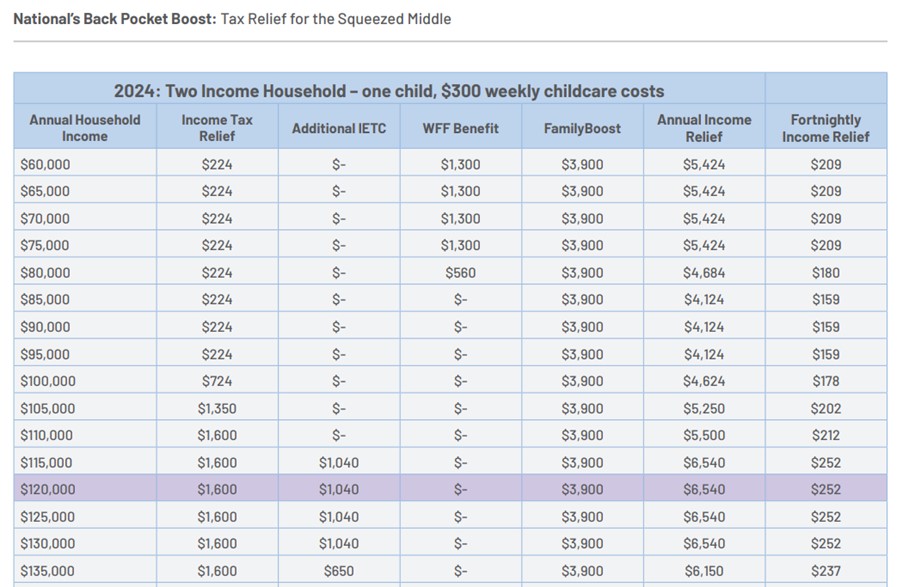This page briefly analyses the distribution of the claimed $252 a fortnight through the National Party tax plan.
To get the maximum tax cut under National’s plan, a household needs to maximise both the personal income tax cuts and the Family Boost childcare tax rebate.
This means:
- The family must be spending at least $300 per week on childcare. National’s Family Boost rebate is 25% up to a maximum of $75 per week. $75 per week x two weeks = $150.
- Additionally, there need to be two adults, each earning between $53,500 and $66,000 (household income $107,000-$132,000). This gets them each a $25.30 per week tax cut ($15.30 per week income tax cut plus $10 per week Independent Earners’ Tax Credit). $25.30 per week x two adults x two weeks = $102.
- $150 Family Boost rebate plus $102 tax cuts = $252 per fortnight. This is shown in National’s table in its tax policy document.
This is demonstrated in Nationals table within their Tax Plan.

The generous estimate is that 3,000 households out of 1.63 million would get this tax cut. This occurs through the following process:

How many households are couples with dependent children?
According to Statistics NZ Household Labour Force Survey, 467,600 of 1,631,400 households are couples with dependent children. 29% of households.
| Region | Total Regions | |||||
| Household Type | Total Household Type | Couple with one dependent child | Couple with two dependent children | Couple with three or more dependent children | Couple with dependent and adult children | |
| Measure | Number of households (000) | |||||
| Year: 2023 | 1631.4 | 138.4 | 189.4 | 84.4 | 55.4 | |
data extracted on 04 Oct 2023 22:06 UTC (GMT) from NZ.Stat
How many households have ECE expenses?
According to Statistics New Zealand, 8.3% of households have ECE expenses. Assuming all these households are couples, this amounts to 135,500 households.
| Year | 2019 | |||||
| Household composition | All households | Couple with one dependent child | Couple with two dependent children | Couple with three or more dependent children | ||
| Expenditure category | Measure | |||||
| Early childhood education | Average weekly household expenditure | 6.6 | 23 | 31.2 | 19.1 | |
| Percentage of households reporting | 8.3 | 23.7 | 33.1 | 31.6 | ||
How many households spend $300 per week or more on ECE?
According to the same data, the average household spends $6.60 a week on ECE, or $10.7m total. The mathematical maximum number of households spending $300 per week is, therefore, 35,500.
How many of these households have incomes between $107,000 and $132,000?
Statistics NZ Household Economic Survey data suggests 17% of couple households with children have incomes in this range. Assuming they account for 17% of couple households with $300 per week ECE expenses, that would mean 6,000 households with both the required income and ECE expenses.
How many of these households have the correct income split?
To maximise the tax cut both adults need incomes between $53,500 and $66,000. This is not necessarily the case. It is possible that only one or neither of the adults have an income in the required range. Only 9% of taxpayers have incomes in this band. A very generous estimate would be that half of these households have both adults in the required income band. This equates to 3,000 households.
Comparisons from National’s tax package
The total Income Tax cuts, Independent Earner Tax Credit and Working for Families increases, and Family Boost come to $3.04b in 2024/25 spread among 4.5m taxpayers, or $13 a week per taxpayer.
- 1 million taxpayers with incomes below $14,000 get no tax cut.
- At least a million taxpayers get only $2 a week ($1.6m have incomes between $14,000 and $48,000 up to 300,000 may get additional IETC payments, and up to 300,000 may get additional Working for Families payments).
- The 120,000 private landlords would get an average tax cut of $6,750. ($810m a year: $760m for interest deductibility and $50m for bright line).
- 3,000 households get $252 per fortnight.
- 350,000 beneficiaries stand to lose up to $40 a week from National slowing the rate of benefit increases.








